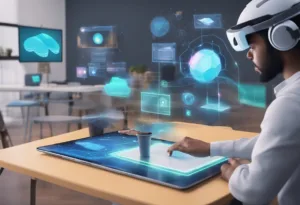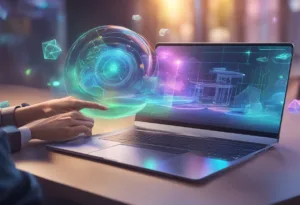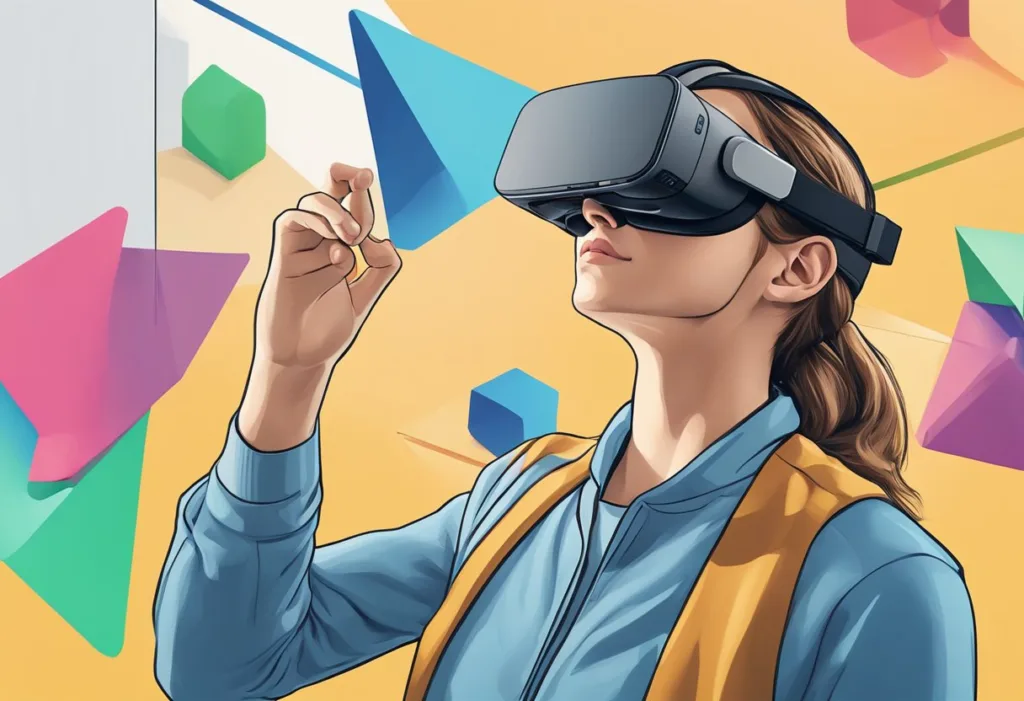Mixed reality (MR) is an emerging technology that combines elements of both virtual reality (VR) and augmented reality (AR). It is a seamless blend of the digital and physical worlds, creating a new environment where virtual objects coexist and interact with the real world. MR is an advanced form of AR that takes the concept to the next level, allowing virtual objects to interact with the real environment to create a whole new level of immersion. In this blog post, I will share with the concept of mixed reality and how does mixed reality expand on augmented reality.
Augmented reality, on the other hand, is a technology that overlays digital information onto the real world. AR enhances the user’s perception of the real world by adding computer-generated sensory input, such as sound, video, graphics, and GPS data. It is widely used in various applications, including gaming, education, healthcare, and marketing.
By combining AR and VR, mixed reality offers a unique and innovative way to interact with the world around us. With MR, users can experience a level of immersion that was previously impossible with AR alone. This emerging technology has the potential to revolutionize the way we interact with the world and create new opportunities for businesses and individuals alike.
Understanding Mixed Reality
Mixed Reality (MR) is an advanced form of technology that combines elements of both Virtual Reality (VR) and Augmented Reality (AR) to create a new environment where virtual objects coexist and interact with the real world. It is an immersive technology that seamlessly blends the digital and physical worlds together, providing users with a unique and interactive experience.
The Evolution from AR to MR
Mixed Reality is an evolution of Augmented Reality, which overlays digital content on top of the real world. Unlike AR, MR goes beyond the mere overlay of digital content and provides users with a fully immersive experience. It does so by using sensors and spatial mapping to track the user’s physical surroundings and create a mesh of the real world. This mesh is then used to place virtual objects in the real world, making it possible for users to interact with them in a more natural and intuitive way.
Key Components of MR
The key components of Mixed Reality include AR glasses or a head-mounted display, spatial mapping, tracking, and interaction. AR glasses or a head-mounted display are used to display virtual objects in the real world, while spatial mapping is used to create a mesh of the real world. Tracking is used to track the user’s physical movements and adjust the virtual objects accordingly. Interaction is used to enable users to interact with the virtual objects in a more natural and intuitive way.
How does Mixed Reality Expand on Augmented Reality?
Mixed Reality expands on Augmented Reality by providing users with a more immersive and interactive experience. It does so by using the mesh of the real world to place virtual objects in the real world, making it possible for users to interact with them in a more natural and intuitive way. This makes it possible for users to experience a more seamless integration between the digital and physical worlds.
Role of the Mesh in Augmented Reality
The mesh plays a crucial role in Augmented Reality by providing a framework for the placement of virtual objects in the real world. It is created using spatial mapping, which allows the system to understand the physical surroundings and create a mesh of the real world. This mesh is then used to place virtual objects in the real world, making it possible for users to interact with them in a more natural and intuitive way.
Mixed Reality is an advanced form of technology that combines elements of both Virtual Reality and Augmented Reality to create a unique and interactive experience. It does so by using sensors, spatial mapping, tracking, and interaction to seamlessly blend the digital and physical worlds together. With the ever-increasing popularity of immersive technologies, Mixed Reality is poised to revolutionize the way we interact with the world around us.
AR Applications and Industries

Mixed Reality (MR) has a wide range of applications across various industries, from education and training to healthcare, manufacturing, architecture, and gaming and entertainment. MR offers a unique interactive experience that expands on the possibilities of Augmented Reality (AR).
MR in Education and Training
MR is revolutionizing education and training by providing hands-on training and 3D models that allow students to interact with virtual objects as if they were part of the real world. MR is particularly useful in fields that require hands-on training, such as medicine, engineering, and design.
MR in Healthcare
MR is also making a significant impact on the healthcare industry. Surgeons can use MR to visualize 3D models of the human body, allowing them to plan and perform surgeries with greater precision. MR can also be used to train medical professionals and provide patients with an immersive and interactive experience.
MR in Manufacturing and Architecture
In the manufacturing and architecture industries, MR is being used to design and visualize complex structures and products. MR allows designers to see their designs in a real-world context, making it easier to identify potential issues and make necessary changes.
MR in Gaming and Entertainment
MR is also transforming the gaming and entertainment industries. MR offers a more immersive and interactive experience than traditional gaming and entertainment platforms. MR games and experiences allow users to interact with virtual objects in a real-world context, creating a more engaging and exciting experience.
MR is expanding on the possibilities of AR and providing a unique interactive experience across various industries. MR is revolutionizing education and training, healthcare, manufacturing, architecture, and gaming and entertainment. MR offers a new way of interacting with the world, and its applications are only growing.
Technological Integration and User Experience in AR

Immersive and Interactive Experiences
Mixed reality (MR) is an advanced form of technology that combines both virtual and augmented reality to create an immersive and interactive experience. It seamlessly blends virtual and real-world elements, creating a new environment where digital and physical worlds coexist and interact in real-time. This integration provides users with a more engaging and immersive experience, allowing them to interact with holographic objects and other digital elements in the real environment.
The integration of MR technology into hardware devices such as AR glasses and head-mounted displays enables users to experience immersive and interactive experiences. The technology tracks the user’s movements and hand gestures, allowing them to interact with holographic objects and other digital elements in the real environment. This level of interactivity provides users with a more engaging and immersive experience, making it an ideal tool for gaming, education, and training.
Hardware and Software Requirements
The hardware requirements for MR technology are more demanding than those for augmented reality. The technology requires specialized cameras, sensors, and computing power to track the user’s movements and create an immersive experience. The most popular MR device on the market is Microsoft’s HoloLens, which is a self-contained device that does not require a smartphone or computer. The device uses spatial computing and computer vision to create an immersive experience.
Privacy and Security Considerations
As with any new technology, there are privacy and security considerations to be aware of when using MR. The technology tracks the user’s movements and hand gestures, which could raise concerns about privacy and data collection. MR devices require access to the user’s camera and microphone, which could be used for malicious purposes. It is essential to use trusted and reputable MR devices and to be aware of the privacy and security risks associated with using them.
MR technology expands on augmented reality by seamlessly integrating virtual content into the real environment, creating an immersive and interactive experience. The technology requires specialized hardware and software to create an immersive experience and raises privacy and security concerns that must be addressed. However, with the right hardware and software, MR technology has the potential to transform gaming, education, and training by providing users with a more engaging and immersive experience.
Future of Mixed Reality

Mixed reality is an emerging technology that is rapidly revolutionizing the way we interact with the world around us. With the advancements in immersive technology, mixed reality is expected to become an integral part of our daily lives in the future.
Advancements in Immersive Technology
The future of mixed reality is promising, as it offers a more interactive experience and a sense of presence in the digital world. With the help of artificial intelligence, mixed reality can provide more personalized and immersive experiences. The use of haptic feedback and other sensory inputs can further enhance the immersive experience.
Mixed reality can also be used for virtual meetings and virtual training, making it easier for people to collaborate and learn remotely. The technology can also provide a more engaging and interactive way of visualizing complex data and information, making it easier for people to understand and analyze.
Impact on Society and Work
Mixed reality has the potential to revolutionize the way we work and interact with the world around us. It can provide a more immersive and engaging way of learning, working, and communicating. The technology can also help bridge the gap between physical and digital worlds, creating new opportunities for businesses and industries.
In the future, mixed reality can be used for various applications, such as virtual shopping, remote healthcare, and virtual tourism. The technology can also help people with disabilities to experience the world in a more inclusive way.
Mixed reality is a promising technology that has the potential to transform the way we live, work, and interact with the world around us. As the technology continues to evolve, it will provide more immersive experiences and open up new opportunities for businesses and individuals alike.
Challenges and Limitations
Technical Challenges
Mixed Reality (MR) is a relatively new technology that combines elements of both Augmented Reality (AR) and Virtual Reality (VR). As with any emerging technology, there are several technical challenges associated with MR that need to be addressed. One of the biggest challenges is calibration. MR devices must be precisely calibrated to ensure that the virtual objects are properly aligned with the real world. This can be a time-consuming and complex process, and it can impact the user experience if not done correctly.
Another technical challenge is battery life. MR devices require a lot of power to run, and the batteries can drain quickly, especially if the device is running processor-intensive applications. This can limit the amount of time that users can spend using the device before needing to recharge it.
User Adoption and Preference
In addition to technical challenges, there are also challenges related to user adoption and preference. MR is still a relatively new technology, and many users may be hesitant to adopt it due to privacy and security concerns. Users may also prefer other technologies, such as AR or VR, depending on their specific needs and preferences.
Privacy and security are also major concerns with MR. MR devices use cameras and other sensors to capture data about the user’s environment, and this data can be sensitive. Users may be hesitant to use MR devices if they feel that their privacy is being violated. There are concerns about the security of MR devices and the data that they collect. If these concerns are not addressed, they could limit the adoption of MR technology.
While MR has the potential to revolutionize the way we interact with the digital world, there are several challenges and limitations that need to be addressed. Technical challenges such as calibration and battery life must be overcome, and user adoption and preference must be taken into account. Privacy and security concerns must be addressed to ensure that users feel comfortable using MR devices.
Frequently Asked Questions
What are the key differences between mixed reality and augmented reality?
Mixed reality (MR) is a more advanced version of augmented reality (AR). Unlike AR, which overlays digital objects onto the real world, MR integrates virtual objects into the real world, creating a seamless blend of the two. MR also offers a more immersive experience, allowing users to interact with virtual objects in real-time within their physical environment.
In what ways does mixed reality enhance user interaction compared to augmented reality?
MR enhances user interaction by providing a more realistic and immersive experience. It allows users to interact with virtual objects in the real world, making it easier to visualize and understand complex concepts. MR also provides a more intuitive and natural way of interacting with technology, as users can use hand gestures and other physical movements to interact with virtual objects.
How do advancements in cloud computing and 5G technology contribute to the development of mixed reality?
Advancements in cloud computing and 5G technology have greatly contributed to the development of MR. Cloud computing provides the necessary processing power to render complex virtual objects, while 5G technology provides the high-speed connectivity needed to stream these objects in real-time. These technologies enable MR to be more seamless and responsive, providing a more immersive experience for users.
Why is a high frame rate crucial for a seamless mixed reality experience?
A high frame rate is crucial for a seamless MR experience because it ensures that virtual objects move smoothly and respond quickly to user input. A low frame rate can cause lag and stuttering, which can break the immersion and make the experience feel less realistic. A high frame rate also reduces motion sickness, which is a common problem with VR and MR.
What role does stereoscopic vision play in the functionality of mixed reality systems?
Stereoscopic vision is a key component of MR systems, as it allows users to perceive depth and distance in virtual objects. This is achieved by rendering two slightly different images to each eye, creating the illusion of 3D space. Stereoscopic vision is essential for creating a realistic and immersive MR experience.
How does mixed reality integrate with the concept of the metaverse?
Mixed reality is an important component of the metaverse, which is a shared virtual space where users can interact with each other and digital objects in real-time. MR allows users to interact with virtual objects in the real world, making it a key technology for creating a seamless and immersive metaverse experience.














